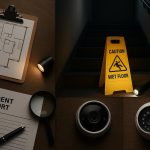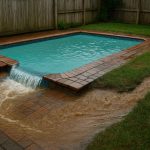A beautiful pool should add ease and enjoyment to your home. It should never introduce expensive surprises. Yet one of the most overlooked elements in pool construction is drainage. When water has no clear path away from the pool structure, the surrounding soil becomes saturated. Over time, that moisture can cause structural damage, cracked decking, and erosion. All of these issues can lead to unexpected repair bills. Understanding how to manage water around your pool protects both your investment and your peace of mind.
Mistake One. Allowing Water to Collect Against the Pool Shell
Water needs a destination. When groundwater or rain funnels toward the pool shell instead of away from it, the pressure around the pool increases. That pressure pushes against the structure. In concrete pools, this can cause cracks. In fiberglass pools, it can create bulging or shifting. A proper drainage system allows excess water to flow around and away from the pool instead of settling near the walls. This can include gravel backfill, weep lines, or drain tile. If your builder skips these steps or backfills with the wrong material, future repairs may be unavoidable. Fixing structural damage to a pool shell can cost thousands, and homeowners almost never see the early signs until the problem becomes massive.
Mistake Two. Ignoring Natural Grade and Slope of the Yard
Many yards are not perfectly level. Some slope toward the pool area without homeowners realizing it. When the ground angles in the wrong direction, stormwater runs toward the deck and foundation. The result is pooling water that seeps through expansion joints and undermines patio supports. If the grade is wrong, the water stays trapped. Fixing this later involves re-pouring concrete or releveling landscaping. Before a pool is installed, the ground should be evaluated and properly graded so that water naturally flows away from the pool area. Proper slope design costs far less than correcting sinking deck slabs after the fact.
Mistake Three. Forgetting about Deck Drainage
Pools look finished when the deck is poured. What you do not see is how water interacts with that surface after the first big rain. Many builders assume that water will evaporate. Homeowners assume the deck drains properly. If the deck sits flat without channel drains or strategic sloping, water collects in low points. That standing water breaks down the surface over time. It can also cause slippery algae growth. Deck repair is both expensive and labor intensive. The simplest way to avoid this problem is to install deck drains or slope the deck slightly so water travels away from the pool and toward planned drainage areas.
Mistake Four. Routing Downspouts Toward the Pool
Rain that hits your roof needs a controlled path to exit. Downspouts that dump water near the pool area create a perfect storm. Instead of reinforcing the soil, the water loosens it. When heavy rain hits, the soil washes out from under the deck. You may see pavers shifting or concrete cracking. Redirecting downspouts is inexpensive. It can also prevent large repair bills later. Use extensions that guide rain into French drains or dry wells placed far from the pool structure. A simple adjustment saves money and prevents erosion that destroys the supporting base of your deck.
Mistake Five. Forgetting to Plan for Overflow
People tend to focus on mechanical equipment and water quality. Overflow design rarely makes the checklist. When heavy rain hits, water levels can rise past the coping. It slides onto the deck and into garden beds. Mulch and soil wash into the pool. Your filtration system works overtime. If your pool does not include an overflow line or skimmer overflow feature, you may end up manually draining water every storm. Builders can install overflow plumbing that moves excess water into proper drainage systems. This protects landscaping and prevents the pool from repeatedly taking in debris.
Mistake Six. Not Including Subsurface Drainage
Surface drains manage what you can see. Subsurface drains manage what you cannot. Water moves underground, and if that water does not have a planned path, it accumulates beneath hard surfaces. Over time, the pressure lifts concrete and shifts pavers. Subsurface drainage, such as perforated drain tile or a French drain system, removes unseen moisture. It preserves the stability of your pool area. Homeowners often skip this step because it feels unnecessary during construction. Later, they discover how costly soil expansion and contraction can be.
Protect Your Investment With Smart Planning
Drainage is not glamorous, but it determines whether your pool lasts or becomes a source of ongoing headache and expense. If you are looking for inground pools in St. Louis, there are contractors who can help. Smart planning keeps water under control. The goal is simple. Keep water moving away from the pool structure, the deck, and the supporting soil. When drainage is done right, your pool remains safe, stable, and beautiful for decades. If you’re planning a new pool or evaluating a current one, review how water flows throughout the space. Small improvements today prevent expensive failures later. An experienced builder will never view drainage as an afterthought. They treat it as the foundation of a long-lasting outdoor escape.
Lynn Martelli is an editor at Readability. She received her MFA in Creative Writing from Antioch University and has worked as an editor for over 10 years. Lynn has edited a wide variety of books, including fiction, non-fiction, memoirs, and more. In her free time, Lynn enjoys reading, writing, and spending time with her family and friends.















